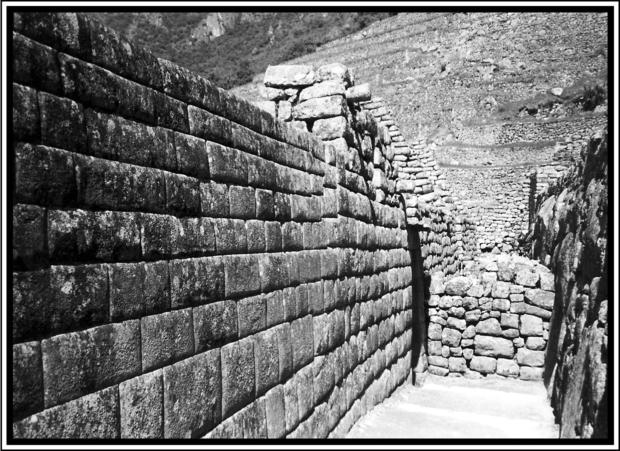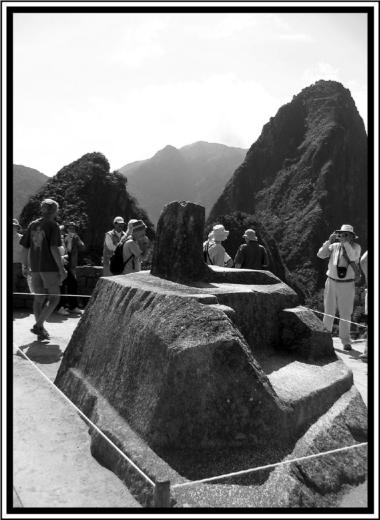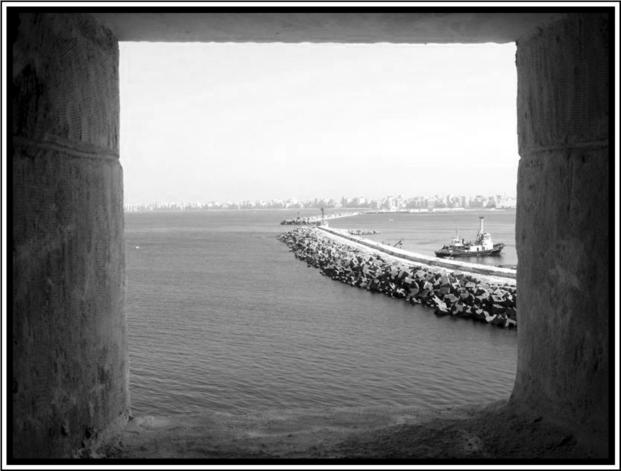Hidden History: Lost Civilizations, Secret Knowledge, and Ancient Mysteries (19 page)
Read Hidden History: Lost Civilizations, Secret Knowledge, and Ancient Mysteries Online
Authors: Brian Haughton
Tags: #Fringe Science, #Gnostic Dementia, #U.S.A., #Alternative History, #Amazon.com, #Retail, #Archaeology, #History

Probably the most spectacular
archaeological site in South America
and the most famous symbol of the
Incas, Machu Picchu (Old Peak), is located in a semi-tropical area 7,000 feet
above sea level in the Andes Mountains
of Peru. It lies about 300 miles southeast of Lima, the modern Peruvian
capital, and 170 miles northwest of
Cuzco, the capital city of the Inca Empire. The vast Inca Empire lasted from
A.D. 1438 to 1533, and was centered in
what is now Peru, but included Ecuador, Bolivia, Chile, part of Argentina,
and the southern end of Colombia. The
Incas were the last of the advanced
native societies of the Andes before the
arrival of the Europeans.
Machu Picchu was known only to a
few local farmers until it was rediscovered in 1911 by Hiram Bingham,
Director of the Peruvian Expedition
of the University of Yale. Bingham was
led to the site by a local farmer named Melchior Arteaga, and at first the
American thought that he and his team
had discovered another lost Inca city
called Vilcabamba. Bingham had read
about Vilcabamba in 16th century
Spanish chronicles as the jungle city
to which the Inca fled after their failed
rebellion against the Spanish. Bingham's party were surprised to find how
remarkably well-preserved the mountain city was, 400 years after it had
been mysteriously abandoned by its
inhabitants. Hiram Bingham was the
first to describe Machu Picchu as "the
Lost City of the Incas" and he used it
as the title of his first book, a bestseller which brought the site international attention. The lost city received
further exposure in 1913 when the
National Geographic Society dedicated
their whole April issue to the site.

(D John Griffiths.
An Inca wall at Machu Picchu.
Machu Picchu was built between
A.D. 1460 and 1470 by Inca ruler and
founding father of the Inca Empire,
Pachacuti Inca Yupanqui, and it seems
to have been inhabited until just before the Spanish conquest of Peru in
1532. The city, with its approximately
200 buildings (including houses, palaces, temples, observatories, and storage structures) is an astonishing
achievement in urban planning, civil
engineering, and architecture. The
complex covers an area of about half
a square mile and can be broadly
divided up into three distinct areas
or districts-agricultural, urban, and
religious. The agricultural section
contains a series of terraces and aqueducts, which utilize the natural slopes
of the land, and function not only
as cultivation platforms but also retention walls to prevent erosion. The area
also includes small, humble dwellings
built around narrow alleys, thought to
have been occupied by farmers. The
urban section of the complex is separated from the agricultural by a wall.
In the southern part of this area is a
series of recesses carved into the rock and named "the jail" by Bingham because of these small niches, where he
thought prisoners' arms were held in
place by stone rings. It is more correctly identified nowadays as part of
the Temple of the Condor, this complex deriving its name from what is
thought to be an Andean Condor carved
into a granite outcrop located at its lowest point. The collection of sophisticated
structures next to the Temple built in
a reddish stone is known as the Intellectuals' Quarters, where there seems
to have been accommodation for the
Amautas (high-ranked teachers), and
also a section known as the Zone of the
Nustas (princesses).
The Three-Windowed Temple,
named for its three large trapezoidal
windows that open onto the main
plaza, contains a carved stone with figures symbolizing the three levels of the
Andean World: the Hanan-Pacha (the
higher world or heavenly paradise),
the Kay-Pacha (the earthly world), and
the Ukju-Pacha (the inner world where
the gods live). The religious section
also includes the Sacred Temple, an
excellent example of Inca stonemasonry, with large polished stone
blocks perfectly joined together, the
Priests' House, and an enigmatic
shrine known as the Intihuatana, or
Hitching Post of the Sun. This is one
of the most important and mysterious
constructions at Machu Picchu. It is
composed of a column of granite, probably the gnomon or pointer of a sundial, rising from a huge pyramidal
table-stone, and it is thought to have
functioned as a solar observatory.
At each winter solstice, during the
Festival of Inti Raymi (or Festival of
the Sun), the god would be symbolically
secured to the stone by a priest in an
attempt to prevent the complete disappearance of the sun.

(D John Griffiths.
The Intihuatana (hitching post of the
sun), probably used as a solar
observatory by the Incas.
The religious section contains
splendid Inca architecture and masonry work. Its main part consists of
the Sacred Plaza, the scene of popular
ceremonies, surrounding the most significant buildings at Machu Picchu.
The Sun Temple is a semicircular construction cut into the solid rock containing two windows, one facing to the
east and the other towards the north.
According to modern scientists, these
two windows were used as a solar observatory; the east-facing window allowed an accurate measurement of the
winter solstice by measuring the
shadow cast by the central stone.
The main feature of Machu Picchu,
and one that has amazed countless visitors, is the fine quality of the massive
stone walls and buildings, constructed
without mortar, using neither the
wheel nor draught animals. Much of
the characteristically polygonal masonry in these structures locks together so precisely that it is impossible
to fit even the thinnest knife blade in
between the joints. This Inca design
ensures the stability of the structure
in an area well-known for earthquakes. Due to the fine quality of the
masonry and the apparent difficulty in
transporting and erecting such huge
stones, some alternative theorists
have conjectured that laser technology
was employed to build the structures
at Machu Picchu, either by some lost
ancient civilization or extraterrestrial
visitors. The mystery of Machu
Picchu's construction is further enhanced by the lack of any documentary
evidence to indicate exactly how the
buildings were erected. Research has
shown that the Incas had a class of
professional architects to design and
organize the construction of such building complexes as Machu Picchu. When
considering Inca architecture, it is vital to understand that these architects
were experts at adapting the form of
the construction to the landscape in
which they were built. Consequently,
existing rock formations were utilized
in construction, sculptures were
carved into rock faces, and water
flowed through stone channels.
Though it is not known exactly how
the Inca moved such enormous blocks
of stone, the general belief is that they
used all the able-bodied men from captured tribes to push the stones, perhaps after levering them onto smaller
spherical stones, and then rolling
them forward, moving the stones from
the back to the front as they progressed. Most of the buildings and
walls at the site were constructed of
granite blocks, and possibly cut with
bronze or stone tools, and finally
smoothed off with sand.
The actual function of Machu
Picchu has been much debated. Was it
a great Inca city with a large, thriving
population? Probably not. It has been
estimated that only about 1,000 people
lived in and around Machu Picchu at
any one time, which, along with its isolated position, indicates that it cannot
really have been a conventional city.
Hiram Bingham's excavations in the
early 20th century revealed 135 mummified corpses, 109 of which Bingham
identified as female. From the predominantly female burials Bingham
deduced that the site functioned
mainly as a refuge of the Acllas, the
Inca Virgins of the Sun. However, more
recent analysis of the skeletons has
indicated that the skeletons were in
fact evenly divided between males and
females. The current theory is that the
complex was a ceremonial city, which
also functioned as a royal estate and
religious retreat or sanctuary for Inca
royalty, priests, and priestesses.
Machu Picchu's sudden abandonment is shrouded in mystery. During
the time of the Spanish Conquest the
sacred city lay undiscovered, which
suggests that it had long been deserted
and forgotten. Theories for the unexplained abandonment are legion and
include the city running dry in an extended period of drought, a disastrous
fire, or because of evacuation during
the time of Inca resistance to the Spanish. Probably the most viable theory points to the fact that, prior to the
Spanish Conquest, smallpox had been
introduced to Peru from Europe; it
soon reached epidemic proportions
and spread through the country. By
1527, half of the population had fallen
victim to the disease, the government
began to collapse, and civil war
erupted. A lack of social order and a
drastically reduced population would
explain a relatively swift desertion.
Today, this amazing mountain-top
complex of temples, cyclopean walls,
fields, and terraces is a Historic
National Sanctuary, protected by
the Peruvian Government, and since
1983, a UNESCO World Heritage Site.
The lost city of the Incas is no longer
lost; it attracts around 500,000 foreign
visitors per year and is by far the most
visited tourist attraction in Peru. Although the Peruvian government
maintains that there are no problems
resulting from such a vast amount of
tourists tramping all over the site,
UNESCO has expressed fears about
the possible damage caused by this
volume of tourism, and in 1998 added
Machu Picchu to its list of endangered
World Heritage sites. Unfortunately,
over the last few years Machu Picchu
has become involved in unwanted controversy. During the filming of a beer
commercial in September 2000, at the
Intihuatana, where Inca priests and
priestesses once worshipped the sun,
a 1000 pound crane toppled over,
breaking off a sizeable piece of the sundial, resulting in criminal charges being filed against the production
company by Gustavo Manrique of the
National Institute of Culture. In 2005,
the same year that Machu Picchu became twinned with the ancient town
of Petra in Jordan, Peru began a legal
battle for the return of the thousands
of artifacts removed from the site by
Hiram Bingham 90 years previously.


©Ahmed Dokmak (GNU Free Documentation License)
Modern Alexandria from one of the windows of Qaitbay's Citadel, to the west of the city.
